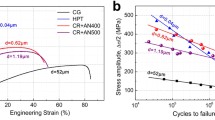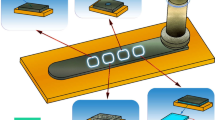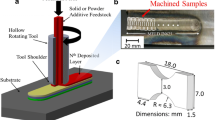Summary
-
1.
Cladding causes a substantial reduction in fatigue strength of Duralumin in air.
-
2.
The degree of protection offered by the cladding material against corrosion by ambient media is reduced by alternating stresses.
-
3.
It was established that residual compressive stresses are set up in the cladding layer; their magnitude decreases from a maximum of 6 kgf/mm2 at the specimen surface to 4.5 kgf/mm2 at the cladding layer/alloy D16AT interface.
Similar content being viewed by others
References
S. I. Kudinov, Effect of Stress Upon the Corrosion of Aluminum Alloys [in Russian], Trudy KhVAIVU, 43, 1956.
G. V. Karpenko, Strength of Steel in Corrosive Media [in Russian], Mashgiz, 1963.
I. L. Oding, Permissible Stresses in Mechanical Engineering and Fatigue Strength of Metals [in Russian] Mashgiz, 1962.
I. A. Birger, Residual Stresses [in Russian], Mashgiz, 1963.
S. I. Kudinov, Corrosion-Fatigue Strength of Aluminium Alloys in Humid Atmospheres [in Russian], 71, Kharkov, 1957.
A. V. Karlashov, A. D. Gnatyuk, and V. P. Tokarev, FKhMM [Soviet Materials Science], no. 4, 1965.
Author information
Authors and Affiliations
Rights and permissions
About this article
Cite this article
Karlashov, A.V., Tokarev, V.P. & Batov, A.P. The role of cladding in the fatigue of Duralumin. Mater Sci 1, 483–486 (1966). https://doi.org/10.1007/BF00715230
Issue Date:
DOI: https://doi.org/10.1007/BF00715230




